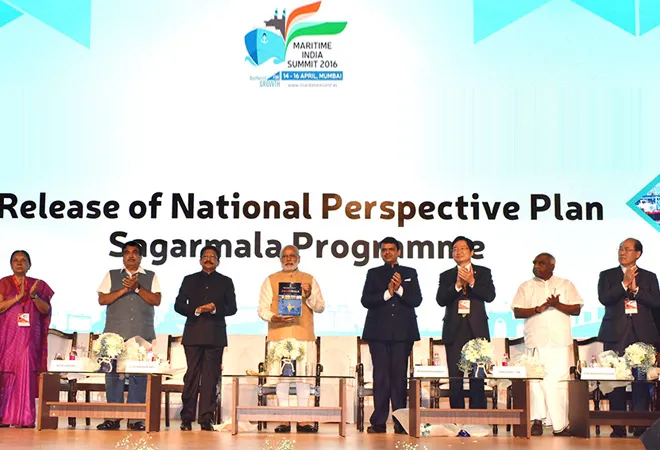
India’s Ministry of Shipping’s Sagaramala National Perspective Plan is admirable in having lent an urgency and purpose to coastal infrastructure projects, by aiming to plug gaps between good ideas and their implementation.<1> A flagship project of the Narendra Modi government adopted in April 2018, it plans to develop at least 14 Coastal Economic Zones (CEZ) and 29 Coastal Economic Units (CEU). The ambitious undertaking also envisages the development of mines, industrial corridors, rail, road and airport connectivity with the ports is expected to yield an export revenue growth of US$110 billion and generate over 1,50,000 new jobs.
Notwithstanding its vision for ushering in broader economic development, Sagarmala has remained silent on the management of wastes entering the coastal areas from large river systems. This is no small matter as the Sagarmala has a socio-economic dimension that promises sustainable development. Beyond navigable waterways and port-led development, the project envisions coastal community development, including a clean maritime environment.
An important aspect of environmental protection is the fight against plastics in river-bodies. These are different from the general detritus or plastic dumped on the coasts by the locals, municipalities or the industries. Research shows that of the ten major river systems of the world contributing 90 percent of inflow of plastic in the oceans, three are in India. The Indus River carries the second highest, followed by Brahmaputra and Ganga that together account for the sixth highest amount of mismanaged plastic debris to the sea.
Notwithstanding its vision for ushering in broader economic development, Sagarmala has remained silent on the management of wastes entering the coastal areas from large river systems. This is no small matter as the Sagarmala has a socio-economic dimension that promises sustainable development.
The debris include plastic bags, micro-plastics, or small plastic particles from cosmetics, tyres, artificial grass, paints and clothes, etc. These not only affect coastal populations and marine ecosystems, but also pose a bigger threat to the human food chain. The enormous chemical content in river-borne plastics endangers the entire aquatic and coastal ecosystem, underscoring the need for a sustainable coastal and marine environment. Since India collects most of its oceanic data using remote sensing which restricts information only to upstream ocean, the enormity of the problem of plastic debris in oceans is under captured.
According to recent studies, the reduction of plastic input from the catchment areas of the top polluting rivers, can dramatically curtail the waste outflow into the oceans. For an ambitious pan-national project like the Sagarmala — which includes riverine infrastructure development — it is imperative to integrate existing environment programs such as Swachh Bharat and the National Mission for Clean Ganga (NMCG). The latter have adopted a comprehensive approach to include solid waste disposal, wastewater management, industrial pollution and river front development.
Why, one wonders have Sagarmala project managers been imperious to the need to prevent litter and plastic pollution at the marine end of rivers. It is worrying enough that the 2018 Coastal Regulation Zone (CRZ) notification issued by the Ministry of Environment, Forests and Climate Change (MoEFCC) has made it easier to implement government ventures lacking necessary environmental clearances. The fact that the proposed regulations threaten the environment and the livelihood of local fishing communities, points to a general apathy for matters of conservation and sustainability.
It is clear that the Ministry of Environment has not been looking at infrastructure projects in holistic fashion. India continues to mobilise several local clean and green ideas simultaneously without linking them with a joint national perspective. The Ministry of Earth Sciences, the National Institute of Oceanography, the Indian National Centre for Ocean Information Services, Centre for Marine Living Research, Ecology, and the National Biodiversity Authority have at best persisted with rudimentary initiatives to foster environmental cleanliness. Even so, none has had river related sub-bodies working to manage problems at the delta end of rivers.
Although India, along with 193 other nations, has signed
a resolution to reduce marine plastic waste at the
United Nations Environment Assembly in Kenya in 2017, it hasn’t laid down specific targets to eliminate major sources of marine litter, plastics and other waste by 2022.
In the conditions that prevail today, New Delhi’s commitment to the Sustainable Development Goals appears shaky. The SDG creates a framework to sustainably manage and protect marine and coastal ecosystems from land-based pollution. But even as the NDA government has worked towards the development of ocean-based resources, it does has little to mitigate the challenges facing our rivers and seas.
Experts observe the tremendous potential for India to collaborate with China and Africa and other international organisations since majority of plastic waste reaches the world’s oceans through ten major rivers. The need of the hour is to identify partners that can help in the evolution of programmes for cleaning India’s major river systems. Whatever modern world-class infrastructure, industrial corridors, rail, road and airport linkages India might create, it is indeed worthless without sustainable systems.
If Sagarmala is to succeed, it must define steps to manage and contain pollution, plastic or chemicals and have a clear focus on its clean environment agenda.
References
<1> http://nationalinterest.org/blog/the-buzz/revealed-indias-master-plan-the-indian-ocean-13198
https://www.sciencedaily.com/releases/2017/10/171017110028.htm
https://india.mongabay.com/2018/01/12/indus-brahmaputra-and-ganga-among-the-top-10-plastic-waste-carrying-rivers/
The views expressed above belong to the author(s). ORF research and analyses now available on Telegram! Click here to access our curated content — blogs, longforms and interviews.




 PREV
PREV


